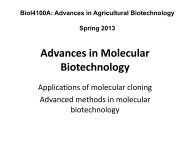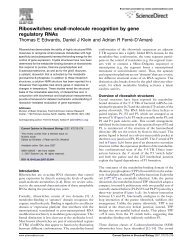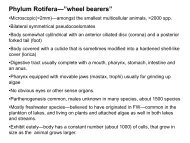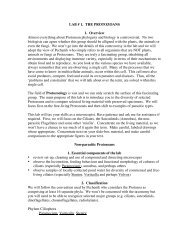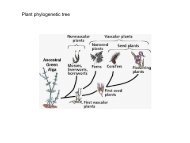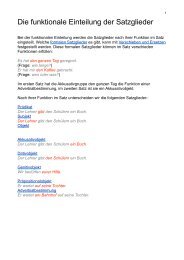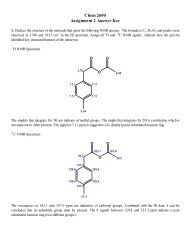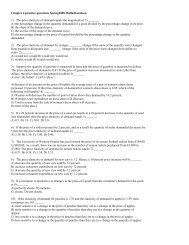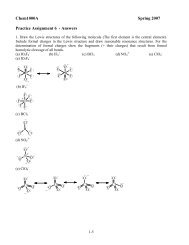Leaf has 3 axes:1) proximodistal, 2) centrolateral, 3) ab-adaxial ...
Leaf has 3 axes:1) proximodistal, 2) centrolateral, 3) ab-adaxial ...
Leaf has 3 axes:1) proximodistal, 2) centrolateral, 3) ab-adaxial ...
Create successful ePaper yourself
Turn your PDF publications into a flip-book with our unique Google optimized e-Paper software.
<strong>Leaf</strong> <strong>has</strong> 3 <strong>axes</strong>:1) <strong>proximodistal</strong>, 2) <strong>centrolateral</strong>, 3) <strong>ab</strong>-<strong>adaxial</strong><br />
Primordium starts out as a peglike<br />
outgrowth that is radially<br />
symmetrical<br />
Figure 5-1<br />
Figure 1-7<br />
1) Proximodistal axis:<br />
•cell divisions end first at the tip, then stop proximally<br />
• cell differentiation is complete first at the tip<br />
•petiole is distinct from the blade<br />
2) Centrolateral<br />
•Midrib is a thickened region surrounding the midvein<br />
•<strong>Leaf</strong> margin is at the leaf edge<br />
1
3) <strong>ab</strong>-<strong>adaxial</strong><br />
•Growth rate is different - cells on <strong>adaxial</strong> side divide more, resulting in<br />
the leaf flattening<br />
•Epidermal cells are different on <strong>ab</strong> and <strong>adaxial</strong> sides (trichomes,<br />
stomata, cell size and shape)<br />
•Internal cell arrangement is polarized (palisade mesophyll on <strong>adaxial</strong>,<br />
spongy on <strong>ab</strong>axial, xylem <strong>adaxial</strong>, phloem <strong>ab</strong>axial)<br />
•Incision is made isolating I1 from SAM<br />
•Radially symmetric leaf, with <strong>ab</strong>axialized epidermis, uniform<br />
parencyhyma, core of vascular tissue<br />
Bowman et al., 2002<br />
Signal from SAM is necessary to <strong>adaxial</strong>ize tissue<br />
Figure 5-2<br />
•In potato, isolation of<br />
I1 from the meristem<br />
results in <strong>ab</strong>axialized<br />
radial leaf<br />
•Abaxial-<strong>adaxial</strong> axis<br />
could be restored by<br />
including a small<br />
amount of the apex<br />
adjacent to I1<br />
•Adaxial side was<br />
towards the new<br />
meristem<br />
•Again, suggests <strong>adaxial</strong><br />
signal comes from<br />
meristem<br />
Sussex, 1951<br />
phantastica<br />
•Most extreme phenotype is needle-like, radially symmetrical leaves<br />
•Adaxial cells are replaced by <strong>ab</strong>axial<br />
Waites and Hudson, Development 1995<br />
2
Phantastica<br />
•PHAN is a MYBtranscription<br />
factor<br />
•Expressed uniformly<br />
throughout the leaf<br />
primordia<br />
•May respond to<br />
putative <strong>adaxial</strong>izing<br />
signal from the SAM<br />
•PHAN is orthologue to<br />
AS1 in Ar<strong>ab</strong>idopsis and<br />
ROUGH SHEATH2<br />
(RS2) in maize<br />
•KNAT1 and KNAT2<br />
overexpressed in AS1<br />
Bowman et al., 2002 leaves<br />
wt<br />
Filamentous flowers (fil)<br />
have flowers missing<br />
petals and stamens (B) or<br />
the only form filaments<br />
FIL = zinc finger<br />
transcription factor<br />
Sawa et al. 1999<br />
X-Gluc<br />
DAP<br />
I<br />
Wt - trichomes on <strong>adaxial</strong><br />
35S::FIL - filaments, no trichomes<br />
35S::GUS<br />
35S::FIL::<br />
GUS<br />
Wild type surface<br />
FIL localizes to the nucleus - transcription factor<br />
Member of gene family, YABBY3, also causes <strong>ab</strong>axialization<br />
35S::FIL surface<br />
Sawa et al. 1999<br />
Overexpression of FIL (35S::FIL) leads to <strong>ab</strong>axialized filamentous leaves<br />
(no trichomes) or leaves with patches of <strong>ab</strong>axialized cells amongst <strong>adaxial</strong><br />
3
Induction of Ectopic Meristems on the Lateral Organs of fil-8 y<strong>ab</strong>3-2 Plants<br />
Wild type<br />
Misexpression of KNOX Genes in y<strong>ab</strong> Mutants<br />
fil-8<br />
Ectopic meristems<br />
suggest activation of<br />
STM, KNAT1 or WUS<br />
BP::GUS<br />
(BP =<br />
KNAT1)<br />
STM<br />
Wild type<br />
fil-8 y<strong>ab</strong>3-2<br />
Copy right ©2002 American Society of Plant Biologists<br />
Kumaran, M. K., et al. Plant Cell 2002;14:2761-2770<br />
Copy right ©2002 American Society of Plant Biologists<br />
Kumaran, M. K., et al. Plant Cell 2002;14:2761-2770<br />
•Misexpression of mersitem genes (STM, KNAT1) results<br />
in <strong>adaxial</strong> - <strong>ab</strong>axial cell fate specification?<br />
•Or lack of <strong>adaxial</strong> causes lack of those things that repress<br />
STM/KNAT1<br />
•Or are there two functions, one in fate specification, the<br />
other in STM, KNAT1 regulation?<br />
•Authors favour second hypothesis - mutants are less<br />
severe in fate specification but show more STM/KNAT<br />
misexpression, suggesting the effects are not correlated<br />
•ago and phn<br />
(ago1/ago1 pnh/+)<br />
mutants un<strong>ab</strong>le to<br />
maintain a meristem<br />
•Mutants in AGO<br />
may show a reversal<br />
of leaf polarity<br />
Kidner and Martienssen, 2004<br />
4
Figure 5-4<br />
•AGO - PAZ and PIWI domains - common in eukaryotes<br />
•Required for RNA interference (part of RNA interference complex)<br />
that targets mRNA for degradation<br />
•PNH (also PAZ and PIWI domains - overlaps AGO function)<br />
expressed in leaves - first throughout, then in <strong>adaxial</strong><br />
•Coordination between regions of cell division and cell differentiation<br />
RNA interference<br />
•DICER cuts primiRNA<br />
and premiRNA<br />
in plants to<br />
generate a duplex<br />
DNA<br />
•Duplex DNA is<br />
unwound and loaded<br />
onto RISC,<br />
including AGO<br />
•RISC is guided to<br />
mRNA<br />
•mRNA cleaved<br />
•What mRNAs do<br />
PNH and AGO<br />
target?<br />
Transcriptional<br />
silencing<br />
Kidner and<br />
Martinssen, 2005<br />
Wild type + phb phb phb<br />
Wild type<br />
Ad <strong>ab</strong><br />
phb phb<br />
<strong>adaxial</strong>ized<br />
phb phb<br />
<strong>adaxial</strong>ized<br />
McConnell and Barton, 1998<br />
ph<strong>ab</strong>ulosa (dominant) plants are severely <strong>adaxial</strong>ized<br />
McConnell and Barton, 1998<br />
Wild type phb +<br />
Radially symmetrical<br />
5
Ectopic buds form on <strong>ab</strong>axial side of phb leaves<br />
phb +<br />
Seedling<br />
McConnell and Barton, 1998<br />
•PHB encodes homeodomain, leucine zipper (HD-ZIPIII) containing protein<br />
•Loss of function mutations have no phenotype (redundant with<br />
PHAVOLUTA (PHV) and REVOLUTA (REV) - triple mutants are <strong>ab</strong>axialized)<br />
•Also <strong>has</strong> a sterol/lipid-binding domain<br />
•PHB is expressed throughout leaf<br />
•May be activated by sterol/lipid ligand only in <strong>adaxial</strong> region (ligand identity<br />
unknown) - could be a ligand secreted by SAM<br />
•Dominant mutations result in constitutive activation<br />
Adaxial cell fate promotes axillary bud development?<br />
Kidner and Martienssen, 2004<br />
•In addition, PHB undergoes miRNA induced degradation on <strong>ab</strong>axial side,<br />
dominant mutant alleles inhibit miRNA induced degradation<br />
•miRNA specific to PHB, PHV and REV is localized initially in meristem,<br />
then on leaf <strong>ab</strong>axial side - signal from meristem?<br />
•PHB mutations disrupt the miRNA binding site - no degradation on <strong>ab</strong>axial<br />
side, therefore <strong>adaxial</strong>ized leaves<br />
•Alleles of AGO that affect the PIWI domain look like PHB mutants<br />
•In ago mutants, PHB is ectopically expressed<br />
•ago mutants enhance the phb phenotype<br />
•In ago mutants, miRNA is ectopically expressed, possibly because it never<br />
gets into degradation pathway<br />
l<strong>ab</strong>el<br />
Nontransformed<br />
PHV is degraded by AGO1<br />
•AGO+FLAG<br />
allows<br />
immunoprecipitation<br />
Baumberger, N. and Baulcombe, D. C. (2005) Proc. Natl. Acad. Sci. USA 102, 11928-11933<br />
Copyright ©2005 by the National Academy of Sciences<br />
6




